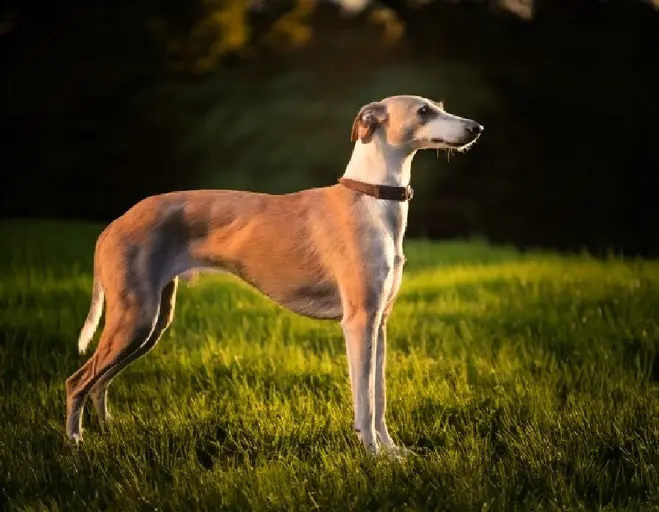Whippet: The Gentle Speedster – A Comprehensive Breed Guide

Brief Introduction
The Whippet, often described as a miniature Greyhound, is a medium-sized sighthound renowned for its elegance, speed, and gentle nature. This breed captivates with its graceful physique, intelligence, and affectionate personality. They are equally happy sprinting across a field or cuddling on the couch, making them adaptable companions for various lifestyles. Their relatively low-maintenance grooming needs and moderate exercise requirements further contribute to their popularity. Whippets possess a unique blend of athleticism and affection, making them a truly special and appealing breed.
Breed History
The Whippet’s history is deeply rooted in 19th-century England, specifically among working-class communities in the north.
Origins and Purpose
Whippets were developed from a mixture of Greyhound, Italian Greyhound, and terrier breeds. Their original purpose was to provide entertainment and supplement the diet of working families. They were primarily used in “snap dog” competitions, where they would race after rags or rabbits released from boxes. This earned them the moniker “poor man’s racehorse.” This selective breeding for racing ability and speed shaped the Whippet into the agile and swift dog we know today.
Evolution and Recognition
Over time, Whippets gained popularity beyond the working class and were recognized by Kennel Clubs. They transitioned from primarily being used for racing and hunting to becoming cherished family companion animals. Breeders refined the breed’s conformation, emphasizing elegance and refinement while maintaining its athleticism. Today, Whippets are appreciated for their versatility, excelling in various canine sports while remaining devoted and loving members of the household.
Appearance
The Whippet boasts a distinctive appearance that reflects its speed and agility.
Size and Build
- Height: Typically stands between 18 to 22 inches (46-56 cm) at the shoulder.
- Weight: Generally weighs between 25 to 40 pounds (11-18 kg). Their build is characterized by a muscular physique with a deep chest, a tucked-up abdomen, and long, slender legs. These features contribute to their impressive speed and agility.
Coat and Color
Whippets have a short, dense coat that lies close to the body. This makes them relatively low-maintenance in terms of grooming. The breed comes in a wide range of colors and patterns, including solid colors, brindle, parti-color (white with patches of color), and various combinations thereof. There is no preferred color, and all are considered acceptable within breed standards.
Head, Ears, Eyes, and Tail
- Head: Long and lean, with a slightly domed skull.
- Ears: Small, rose-shaped, and folded back.
- Eyes: Dark, intelligent, and alert.
- Tail: Long and tapering, carried low when relaxed, but may be curved upwards in a gentle arc when the dog is excited. These features contribute to the Whippet’s refined and elegant appearance, while also reflecting its athleticism and keen senses.
Character and Behavior
Whippets are known for their gentle and affectionate character.
Temperament and Personality
Whippets are generally docile and affectionate dogs that thrive on human companionship. They are known for their calm and quiet demeanor indoors, often described as “Velcro dogs” due to their desire to be close to their owners. Outside, they enjoy opportunities to run and play. Whippets are sensitive and intelligent, responding well to positive reinforcement training methods.
Attitude Towards People, Children, and Other Animals
- People: Whippets are generally friendly and welcoming towards strangers, though early socialization is important to ensure they are comfortable in various social situations.
- Children: They are typically good with children, especially when raised together. However, supervision is always recommended to ensure both the child and the dog interact respectfully.
- Animals: Whippets have a strong prey drive and may chase small animals, especially cats and rabbits, unless properly socialized from a young age. They tend to get along well with other dogs, especially those of similar size and temperament.
Activity Level and Trainability
- Activity Level: Whippets have moderate exercise requirements. They need daily walks and opportunities to run, but they are also content to relax indoors.
- Trainability: Whippets are intelligent and trainable, but they can also be sensitive and easily distracted. Consistent, positive reinforcement training methods are most effective. They excel in canine sports such as agility, lure coursing, and racing.
Breed Characteristics
Whippets are known for their speed and agility, but they are also prone to separation anxiety if left alone for extended periods. They are relatively quiet dogs, but they may bark if bored, anxious, or if they see something that triggers their prey drive. Their sensitive nature makes them responsive to their owner’s emotional state, making them excellent companions for individuals or families seeking a loving and gentle dog.
Care and Maintenance
Proper care and maintenance are essential to ensure a Whippet’s health and well-being.
Grooming
Whippets have a short, smooth coat that requires minimal grooming. Weekly brushing with a soft brush or grooming mitt is sufficient to remove loose hair and maintain a healthy shine. They do not require frequent bathing unless they get particularly dirty. Their nails should be trimmed regularly to prevent overgrowth and discomfort. Regular teeth cleaning is also essential for maintaining dental health.
Exercise
Whippets need regular exercise to stay physically and mentally stimulated. Daily walks are a good starting point, but they also need opportunities to run and stretch their legs. A fenced yard or a dog park is ideal, but they should always be kept on a leash in unfenced areas due to their strong prey drive. Activities such as lure coursing or agility training can provide excellent exercise and mental stimulation for Whippets.
Feeding
A high-quality dog food formulated for medium-sized breeds is essential for maintaining a Whippet’s health. The amount of food they need will depend on their age, activity level, and metabolism. It is important to monitor their weight and adjust their food intake as needed to prevent obesity. Fresh water should always be available.
Health
Whippets are generally healthy dogs, but they are prone to certain health issues, including:
- Mitral Valve Disease
- Hypothyroidism
- Anesthesia Sensitivity
- Eye Problems (e.g., Progressive Retinal Atrophy)
Regular veterinary checkups are important for early detection and treatment of any health problems. Careful breeding practices can help reduce the risk of genetic health issues.
Possible Problems
Whippets can be sensitive to cold weather due to their short coat and low body fat. They may need a coat or sweater during colder months. They are also prone to separation anxiety if left alone for extended periods. Providing them with plenty of toys, puzzle feeders, and interactive playtime can help alleviate boredom and prevent destructive behaviors.
Breed Weaknesses
While Whippets are wonderful companions, they do have certain weaknesses that prospective owners should be aware of.
Prey Drive
Whippets have a strong prey drive, meaning they are likely to chase small animals such as cats, rabbits, and squirrels. This can be challenging for owners who have other pets or live in areas with a lot of wildlife. Proper training and socialization are crucial for managing this instinct, but it is important to understand that it may never be fully eliminated.
Cold Sensitivity
Due to their short coat and lean build, Whippets are sensitive to cold weather. They may shiver and seek out warmth when temperatures drop. Owners may need to provide them with a coat or sweater during the winter months, and they should be kept indoors during extremely cold weather.
Separation Anxiety
Whippets are prone to separation anxiety if left alone for extended periods. They thrive on human companionship and may become anxious and destructive if they feel isolated. Providing them with plenty of toys and interactive playtime can help alleviate boredom and prevent destructive behaviors.
Potential for Escape
Whippets can be escape artists. Their speed and agility means they can easily clear fences if they are determined to chase something. Securing your yard is important.
Not the Best Guard Dogs
Whippets are not inherently aggressive or territorial, so they do not make good guard dogs. Although they might bark at an unfamiliar sound, their friendly nature will generally prevail.
Loyalty
Whippets bond strongly with their families and are extremely loyal.
Conclusion
The Whippet is a unique blend of athleticism and affection, making them an ideal companion for a variety of individuals and families. They are well-suited for those who appreciate a low-maintenance dog with moderate exercise needs and are willing to provide plenty of love and attention. Whippets thrive in homes where they are included in daily activities and receive consistent training and socialization. If you are looking for a gentle, intelligent, and loving companion that enjoys both running and cuddling, the Whippet may be the perfect breed for you. Before bringing a Whippet into your home, consider whether you can meet their needs for exercise, companionship, and proper care.
Frequently Asked Questions About Whippet
- What is a Whippet?
- What is the temperament of a Whippet?
- How much exercise does a Whippet need?
- Are Whippets good with children?
- Do Whippets get along with other animals?
- How much grooming do Whippets need?
- Are Whippets easy to train?
- What are some common health problems in Whippets?
- Are Whippets sensitive to cold weather?
- Do Whippets suffer from separation anxiety?

